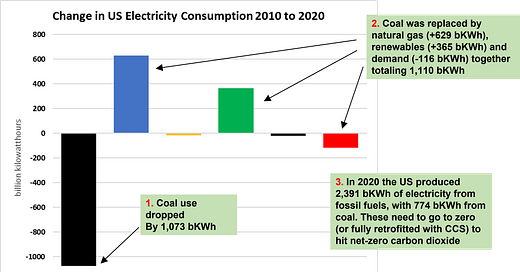From 2010 to 2020 the consumption of coal for electricity in the United States dropped dramatically, by almost 60%. This is good news for climate policy as coal is very carbon intensive. The graph above (with data from EIA) shows that coal generation was replaced by natural gas, renewables and a slight decrease in overall demand (and also compensated for small declined in nuclear and other generation).
Carbon dioxide emissions reductions have been significant, but they are also illusory. Natural gas is much less carbon intensive than coal, but it is still a carbon intensive fuel. Fossil fuel generation for electricity actually declined only about 12% from 2010 to 2020.
To achieve President Biden’s 2035 target for net-zero carbon dioxide, the currently operating 1,926 natural gas power plants and 284 coal power plants would have to be retired and replaced with carbon-free technologies, or retrofitted with carbon capture and storage technologies. That works out to about 185 fossil fuel power plant retirements per year (about 4 per week) to 2035. Currently, the U.S. is not retiring fossil fuel power plants, it is instead building them. According to EIA, 103 new natural gas power plants (capacity >50MW) are planned over the next few years.
Don’t be fooled by falling emissions — that’s a natural gas illusion — for achieving climate targets is is the number of fossil fuel power plants that matters most.





How much natural gas increase is driven by the need to provide backup for intermittent renewables?
Isn't it obvious that the only way to move in the direction of net zero is a large increase in nuclear generation?
So what? What the US does makes no difference. China, India, and Africa will build and use coal fired generating plants at an ever increasing rate. American sacrifices are just meaningless.